Describe homeostasis - Study guides, Class notes & Summaries
Looking for the best study guides, study notes and summaries about Describe homeostasis? On this page you'll find 3892 study documents about Describe homeostasis.
Page 2 out of 3.892 results
Sort by
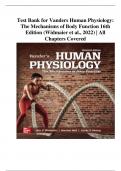
-
Test Bank for Vanders Human Physiology: The Mechanisms of Body Function 16th Edition (Widmaier et al., 2022) | All Chapters Covered
- Exam (elaborations) • 779 pages • 2023
-
- $23.99
- 1x sold
- + learn more
1. Which of these is NOT one of the four general categories of cells that make up the human body? A. epithelial cells B. collagen cells C. connective tissue cell D. neuron E. muscle cell Bloom's: Level: 1. Remember HAPS Objective: A06.01 Describe, in order from simplest to most complex, the major levels of organization in the human organism. HAPS Topic: Module A06 Levels of organization. Learning Outcome: 01.02 Section: 01.02 Topic: Levels of organization 2. Physiology is the study...

-
Test Bank For Essentials of the Living World 6Th Edition By George B. Johnson Complete All Chapters 2023-2024
- Exam (elaborations) • 118 pages • 2023
-
- $18.49
- 1x sold
- + learn more
Test Bank For Essentials of the Living World 6Th Edition By George B. Johnson Complete All Chapters . The simplest organisms do not have nuclei. In the list below, which group has the simplest organisms? A) Bacteria B) Fungi C) Plantae D) Animalia E) Protista Answer: A Explanation: The Bacteria and the Archaea lack even the nuclear membrane which defines a true nucleus. Please see section 1.1. Section: 01.01 Topic: Levels of Biological Organization Bloom's: 2. Understand Learning O...
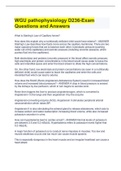
-
WGU pathophysiology D236-Exam Questions and Answers
- Exam (elaborations) • 32 pages • 2022
-
- $9.49
- 17x sold
- + learn more
What is Starling's Law of Capillary forces? How does this explain why a nutritionally deficient child would have edema? - ANSWER Starling's Law describes how fluids move across the capillary membrane. There are two major opposing forces that act to balance each other, hydrostatic pressure (pushing water out of the capillaries) and osmotic pressure (including oncontic pressure, which pushes fluid into the capillaries). Both electrolytes and proteins (oncontic pressure) in the blood affe...
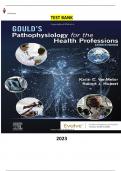
-
Test Bank for Goulds Pathophysiology for the Health Professions 7th Edition by Karin C. VanMeter & Robert J Hubert - Complete, Elaborated and Latest Test Bank. ALL Units (1-28) Included and Updated
- Exam (elaborations) • 214 pages • 2023
-
- $31.00
- 6x sold
- + learn more
Test Bank for Goulds Pathophysiology for the Health Professions 7th Edition by Karin C. VanMeter & Robert J Hubert - Complete, Elaborated and Latest Test Bank. ALL Units (1-28) Included and Updated #Hole #Nursing #health #Human #Anatomy #Physiology #Gould #Pathophysiology #Professions #7thEdition #Karin #VanMeter #Robert #Hubert #Elaborated #TestBank #Latest #updated #2023 Gould's Pathophysiology for the Health Professions 7th Edition by Karin C. VanMeter & Robert J Hubert - ...
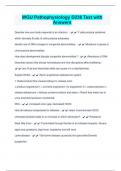
-
WGU Pathophysiology D236 Test with Answers
- Exam (elaborations) • 17 pages • 2024
-
- $9.49
- 1x sold
- + learn more
WGU Pathophysiology D236 Test with Answers Describe how your body responds to an infection. - ️️ -T cells produce cytokines, which stimulate B cells. B cells produce antibodies. Identify role of DNA changes in congenital abnormalities. - ️️ -Mutations in genes or chromosomal abnormalities How does development disrupts congenital abnormalities? - ️️ -Alterations of DNA Describes factors that disrupt homeostasis and how disruptions affect wellbeing. - ️️ -(ex) Fluid and ele...
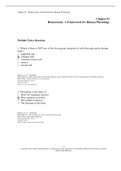
-
Test bank for vanders human physiology 15th edition complete
- Exam (elaborations) • 778 pages • 2022
-
- $20.49
- 5x sold
- + learn more
Test bank for vanders human physiology 15th edition completeChapter 01 - Homeostasis: A Framework for Human Physiology Chapter 01 Homeostasis: A Framework for Human Physiology Multiple Choice Questions 1. Which of these is NOT one of the four general categories of cells that make up the human body? A. epithelial cells B. collagen cells C. connective tissue cell D. neuron E. muscle cell Bloom's: Level: 1. Remember HAPS Objective: A06.01 Describe, in order from simplest to most...
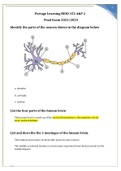
-
Portage Learning BIOD 152 A&P 2 Final Exam 2023/2024
- Exam (elaborations) • 31 pages • 2023
-
Available in package deal
-
- $15.49
- 12x sold
- + learn more
Portage Learning BIOD 152 A&P 2 Final Exam 2023/2024 Identify the parts of the neuron shown in the diagram below a. dendrite b. cell body c. nucleus List the four parts of the human brain The human brain is made up of the cerebral hemispheres, diencephalon, brain stem, andcerebellum. List and describe the 3 meninges of the human brain. The leathery dura mater is the double-layered outer meninx. The middle arachnoid meninx is a loose layer separated from the dura...
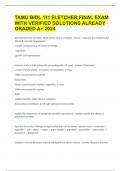
-
TAMU BIOL 111 FLETCHER FINAL EXAM WITH VERIFIED SOLUTIONS ALREADY GRADED A+
- Exam (elaborations) • 36 pages • 2023
- Available in package deal
-
- $14.99
- 1x sold
- + learn more
describe the basic functions all life forms must accomplish -response to environmental stimuli & maintain homeostasis -uptake and processing of nutrients/energy -regulation -growth and reproduction compare and contrast eukaryotic and prokaryotic cell types Prokaryotes: -circular chromosomes, no nucleus, no organelles, 3.5 bya -DNA concentrated in nucleoid Eukaryotes: -linear chromosomes, nucleus, organelles, 1.5 bya -DNA concentrated in nucleus Both: -cellular function takes p...

-
Test Bank For Core Concepts in Health 3Rd Canadian Edition By Jennifer Irwin
- Exam (elaborations) • 1114 pages • 2023
-
- $33.10
- 1x sold
- + learn more
Chapter 03 - Stress: The Constant Challenge True / False Questions 1. A stressful situation would be one an individual perceives as challenging. FALSE Accessibility: Keyboard Navigation Blooms: Remember Difficulty: Easy Learning Objective: 03-01 Explain what stress is and how people react to it-physically; emotionally; and behaviourally. Topic: 03-01 What is Stress? 2. A stressful situation would be one an individual perceives as exceeding her ability to cope. TRUE Accessibility: Keybo...
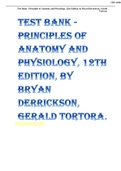
-
Test Bank - Principles of Anatomy and Physiology, 12th Edition, by Bryan Derrickson, Gerald Tortora.
- Exam (elaborations) • 748 pages • 2023
-
- $16.49
- 2x sold
- + learn more
1. This is the study of the functions of body structures. a. Anatomy b. Physiology c. Dissection d. Histology e. Immunology Ans: B Difficulty: easy Feedback: 1.1 2. This is defined as a group of cells with similar structure and function. a. Tissue b. Organ c. Molecules d. Compounds e. Organism Ans: A Difficulty: easy Feedback: 1.2 3. Using your fingers to find your pulse on your wrist is an example of a. Auscultation b. Palpation c. Responsiveness d. Gross anatomy e. Physi...

Did you know that on average a seller on Stuvia earns $82 per month selling study resources? Hmm, hint, hint. Discover all about earning on Stuvia


